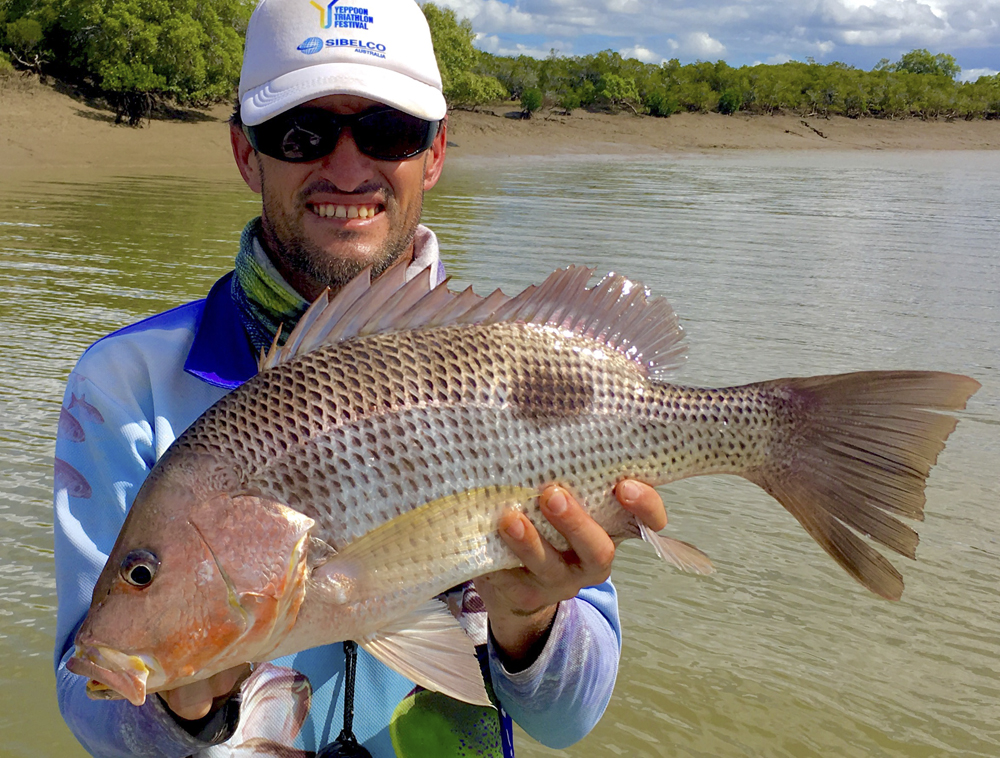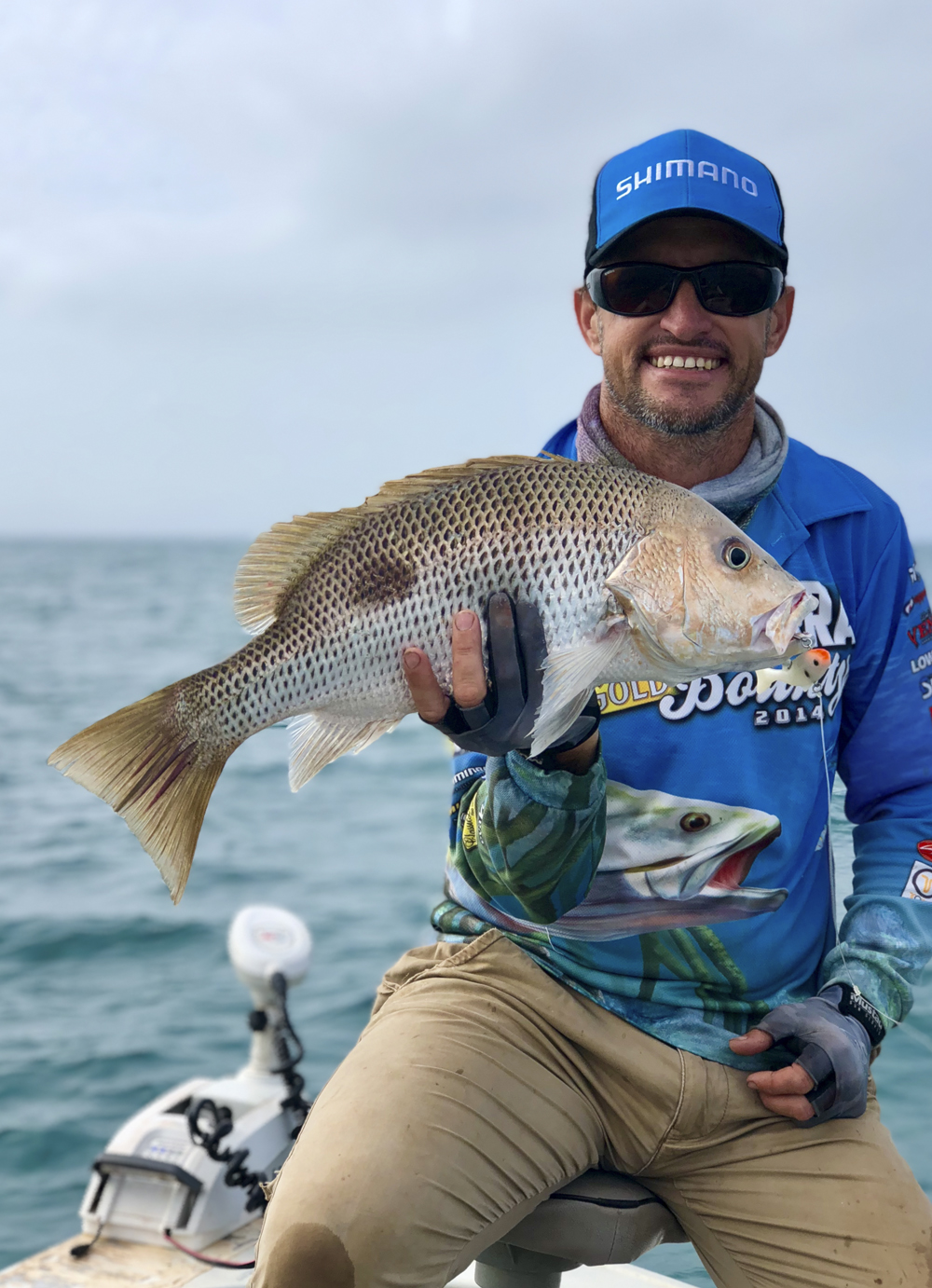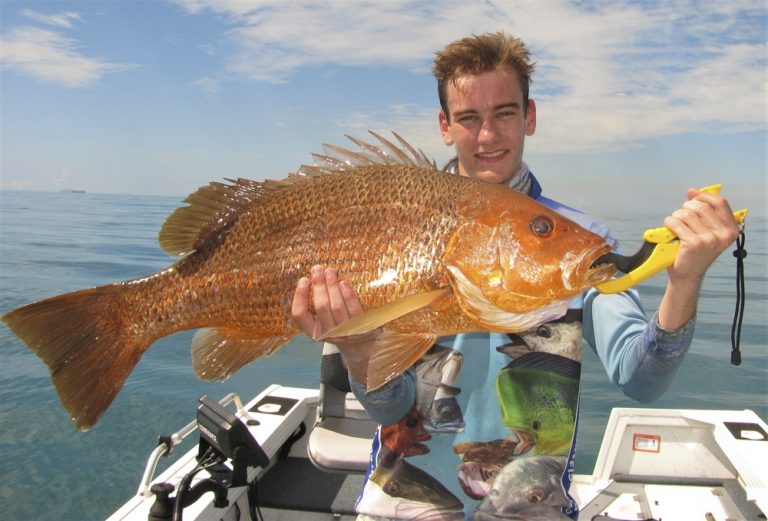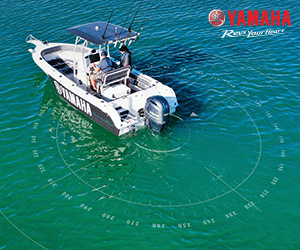Finding Fingermark. By Nathan Johnston
The highly sought-after Lutjanus johnii, aka fingermark carry a distinctive back spot the shape of a thumbprint just below their dorsal fin. The striking fish can take on copper, golden and silvery hues depending on the habitat, depth of water and time of day they are caught, which is the reason they often also go by the name of golden snapper.
These schooling species are found in estuarine, coastal headlands and adjacent inshore reefs across the top half of Australia.
Due to their schooling nature, once one is found, more are often not that far away. They are a slow-growing prime table fish and prone to barotrauma when caught in water deeper than 10 metres so are vulnerable to overfishing. If you get onto a patch, particularly in deeper water, then take a couple for the table and move on so they are available next time you visit the same spot.

These inquisitive schooling fish are great to target with lures and livebait, particularly squid, prawns and live herring. Deep trolled hardbodies work well along with soft plastics and soft vibes. Hopping soft vibes in likely county would have to be my favourite way to target these fish, though, in shallower water, lightly weighted soft plastics seem to produce better results, particularly if the fish are not actively feeding.
Most of the fingermark I have caught have come from habitats where a large vertical structure intersects with mud, sand or gravel. The structure may include rocky ledges, fallen deep water timber and man-made structures, like pylons and wrecks. The schools of fingermark will use this as their home base and during periods of rest will often sit very close to, and even inside this structure if it has a cave or is hollow. While actively feeding fingermark spread further afield away from this structure. Most of the fish I have caught have been during the day, fingermark do tend to have a more active nocturnal hunting preference.
I notice this nocturnal bite period more when bait fishing and the hunch is that the fish spread out and forage more readily at night, meaning that the set baits don’t have to be as close to the structure to be found by the fish. During the day, these fish retreat back where there is more structure or into a cave. As with any rule in fishing, there are always exceptions!! I have found good patches of quality fingermark on gravel beds actively feeding in the middle of the day and readily taking lures presented to them.

In more recent years, and with the advent of quality side and down scan sounders, it has been easier to pinpoint both the structure and the fish. This has made targeting of fingermark during the day a great deal easier. Likely structure can be scanned, and if no fish are present, then one can simply move on to the next patch of likely structure on the list until fish are found. Look for several rounder shows of medium-sized next to likely structure to give you more confidence. Pinpoint the schools and then move downstream of the school if the tidal run is slower or in shallow water and throw up to them with lures. If fishing deeper water, or if there is a bit more run, then employ a vertical jigging technique.
Once found, it is then a matter of dropping something in front of their noses and seeing if a bite can be elicited. When actively feeding, lure or bait presentation is less critical for fingermark. Several mates in the Keppel Bay Sportfishing Club have even taken them on flashas and other metal lures when vertically jigging for smaller mackerel species. When they are more finicky, I have found the scented soft plastics and vibes smeared with scents to be more effective. In this situation, the pace of retrieval is slowed, giving fish the opportunity to use their sense of smell as well as sight. For bait, it works in the opposite fashion. Bait has an inherent scent, but the shimmying movements of a livebait attracts further attention of the fingermark, sending all the right messages to their grey matter that this morsel laid out in front of them is indeed something worthy of swallowing.

Part of the appeal with fingermark is their dogged fighting ability. They put up a great tussle, and this can get the heart pumping even more if they are hooked next to heavy structure! Good quality terminal tackle along with fluorocarbon with high abrasion resistance are sensible choices. Many finer gauge trebles and hooks may not be up to the task of the hand-to-hand combat required next to heavy structure, particularly with the larger specimens. Consider upgrading trebles or selecting something with a bit more attitude to save disappointment. Same goes for the line! While you might luck it with light line, most fish will be lost and left with a length of line and a lure or hook trailing from their mouth. The best approach to take from a conservation perspective is to use a heavier braided line of 20-30lb and get the fish into the boat so that you can unhook them and let them go or catch what you need for a feed and move on to something different.
Hopefully, this helps point you in the right direction to find a few of these great fish.

Spot the difference – mangrove jack, moses perch & fingermark
Anglers who haven’t caught many of these three species (and even some who have) struggle at times to tell the difference between fingermark, mangrove jack and moses perch. Here we compare the three species and provide some tips to help you in telling them apart when out on the water.
Moses Perch
• Brown-grey upper body covered with a pink flush
• Yellow pectoral, pelvic and anal fins
• Black spot below the soft dorsal fin
• Subject to coral reef finfish closure
• Min size limit 25cm. Max possession limit of 5
Fingermark (Golden Snapper)
• Body has a bronze to silver sheen
• Black spot below the soft dorsal fin, though this can hard to see with darker colour variations
• Pectoral, pelvic and anal fins match the colour of the fishes flanks and are never bright yellow
• Not part of the coral reef finfish closure
• Min size limit 35cm. Max possession limit of 5
Mangrove Jack
• Back and sides are greenish-brown to reddish
• Reddish pelvic and anal fins with white margin, particularly along the pelvic fin
• More prominent canine teeth
• No spot or ‘mark’
• Lighter colour variations display whitish vertical bars, particularly juveniles
• Not part of the coral reef finfish closure
• Min size limit 35cm. Max possession limit of 5
Still not sure?
The Lutjanus genus are great food fish, but if you are out on the water and still unsure, the best option is to let it go instead of keeping it. If you are that way inclined that you absolutely must keep a fish, then make sure it is at least 35cm, that you don’t have any more than 5 per person and it isn’t during the coral fin fish closure – that covers legal requirements for all three species.





